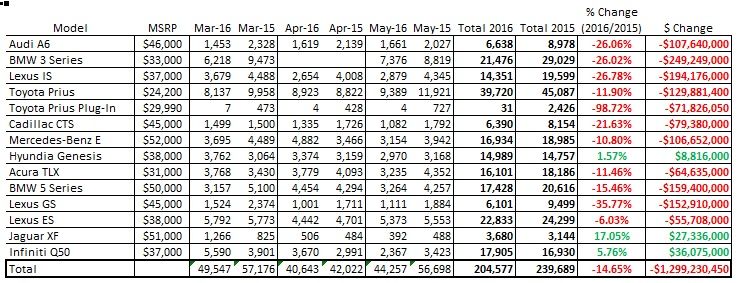It has made me think "Wouldn't that work for a ICE too?" - if a Model-S like design would improve ICE MPG (significantly?) why aren't all recently launched models shaped like that?
I expect the answer is obvious, but it alludes me!
What
@Cosmacelf said, but I'll add a bit.
As speed increases, drag also increases, but ICEs are able to offset this drag effect by gearing the engine so it's working at it's most efficient at around 60-70 mph. Aerodynamic drag begins to become a factor around 25-40 mph. That's the speed range where you're overcoming all the static friction in the system, and aerodynamic drag hasn't become as significant yet.
Because they gear ICE cars to have peak engine efficiency around 60-70, the overall efficiency curve is usually fairly flat from about 30-40 to 60-70. Aerodynamic drag increases, but it's offset by the increase in efficiency from the motor. Over that speed and the efficiency drops as well as aero drag builds up, so the efficiency curve can fall off quite sharply.
ICE motors have an RPM where they are most efficient. Hybrids take advantage of that, running the motor as it's most efficient most of the time to maximize mileage. Electric motors aren't efficient at extremely low speeds because of friction and if you get them going really fast I believe the efficiency drops, but their efficiency is very consistent through a very wide range, easily wide enough for use in an electric car. That's why electric cars don't need transmissions, you may get a little better torque in a higher gear, but the trade off essentially isn't worth it most of the time.
As Comacelf said, ICE engines are very inefficient, though even 33% is probably a bit high for most engines. Electric motors are 80-90% efficient and don't really have a sweet spot RPM like ICEs do. Gasoline has 33 KWh/gal, it's a fantastically dense energy source, and batteries only have about 1 KWh/gal (of volume). EVs make up for this difference by being extremely efficient and an EV that is intended for the highway needs to be as aerodynamic as possible to maximize that efficiency.
ICE companies can and do improve mileage by making cars more aerodynamic. The Model S is shaped like a lot of modern sedans, but where aerodynamics can make a big difference in EV efficiency, it makes a much smaller impact on ICE efficiency.



